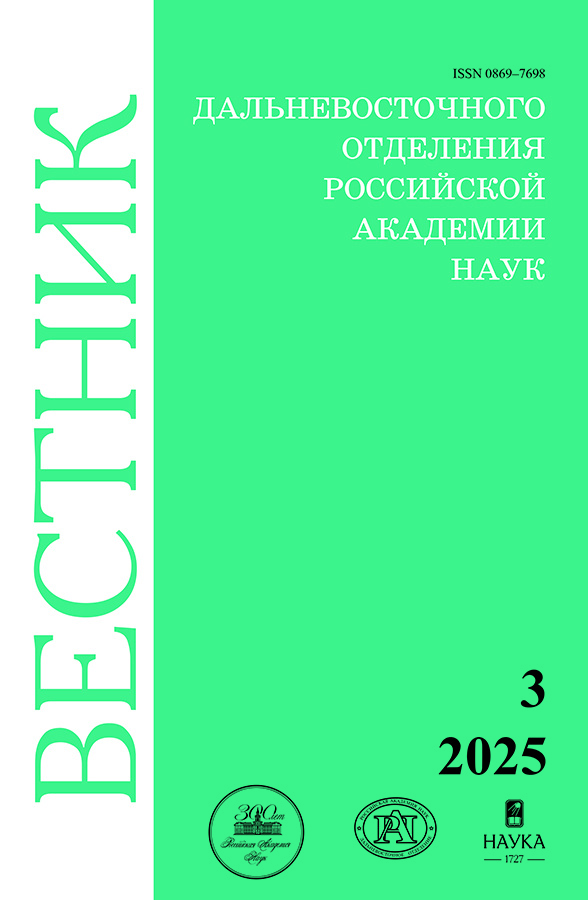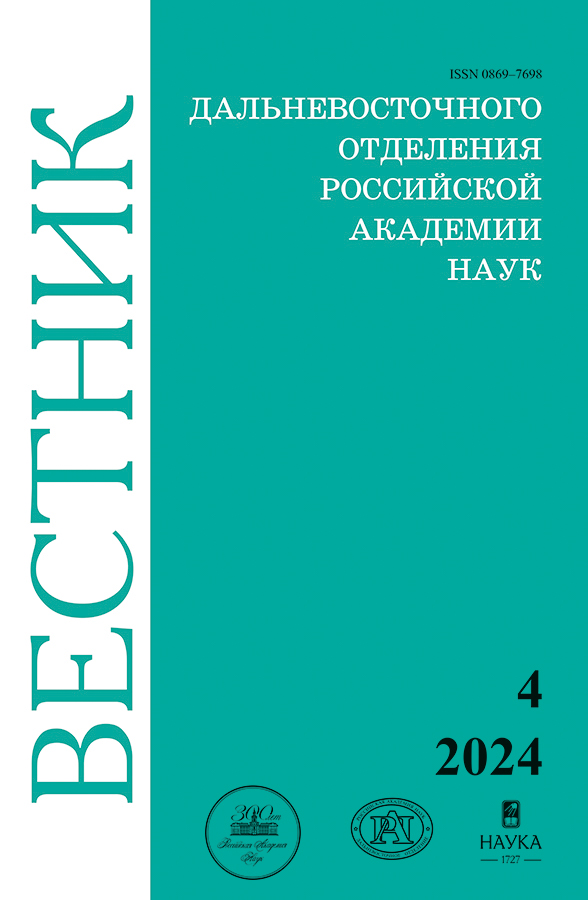Productivity and nutritional value of the forage mass of the common vetch
- Authors: Klochkova N.L.1, Mokhan’ O.V.1, Telichko O.N.2
-
Affiliations:
- Federal Scientific Center of Agrobiotechnology in the Far East named after A. K. Chaika
- Far Eastern Scientific Research Institute of Plant Protection – Branch of the Federal Scientific Center of Agrobiotechnology in the Far East named after A. K. Chaika
- Issue: No 4 (2024)
- Pages: 72-79
- Section: Agricultural sciences. Crop science
- URL: https://permmedjournal.ru/0869-7698/article/view/676045
- DOI: https://doi.org/10.31857/S0869769824040049
- EDN: https://elibrary.ru/IRHFCX
- ID: 676045
Cite item
Full Text
Abstract
The paper presents the results of a study on hybrid specimens of the common vetch (F2–F4) under the conditions of the steppe zone of Primorsky Territory. The garden vetch is a valuable and highly nutritious crop, which can be used for the production of herbage, silage, and hay and grown both independently and in a mixture with legume crops and grasses. The research goal was to create and study a highly productive hybrid material of the common vetch for further use in breeding. We analyzed 143 Vicia sativa L. genotypes from 2020 to 2022, fifteen of which were characterized by high nutritional value. The following hybrid specimens were determined to be the most valuable for further breeding: N2 (Lugovskaya 85 × VIR217), N8 (Lugovskaya 85 × DuPuy), N10 (Lugovskaya 85 × Kshen›), N1 (Lugovskaya 85 × N2252), N11 (Lugovskaya 85 × Monika), N15 (Nemchinovskaya yubileinaya × Lugovskaya 85), and N17 (Mestnaya × Lugovskaya 85). These genotypes were characterized by the highest yield of herbage (0.87–1.24 kg/m2), a high content of digestible protein per 1 kg of the dry matter (108.0–175.5 g), and the highest amount of digestible protein per one Russian feed unit (117.2–198.5 g).
Keywords
Full Text
About the authors
Nataliya L. Klochkova
Federal Scientific Center of Agrobiotechnology in the Far East named after A. K. Chaika
Email: klochova128@mail.ru
ORCID iD: 0000-0002-3958-2509
Junior Researcher
Russian Federation, Ussuriysk, Timiryazevsky stl.Oksana V. Mokhan’
Federal Scientific Center of Agrobiotechnology in the Far East named after A. K. Chaika
Email: oksana.moxan@yandex.ru
ORCID iD: 0000-0002-7660-3348
Candidate of Sciences in Agriculture, Deputy Director for Science
Russian Federation, Ussuriysk, Timiryazevsky stl.Ol‘ga N. Telichko
Far Eastern Scientific Research Institute of Plant Protection – Branch of the Federal Scientific Center of Agrobiotechnology in the Far East named after A. K. Chaika
Author for correspondence.
Email: olgatelichcko@yandex.ru
ORCID iD: 0000-0001-7948-4949
Candidate of Sciences in Agriculture, Leading Researcher
Russian Federation, Primorsry Territory,Kamen-Rybolov vil.References
- Bezgodova I. L., Konovalova N. Yu. Influence of promising species and varieties of legumes on botanical composition, productivity and nutritional value of annual mixtures in the conditions of the European north of Russia. Agricultural and Livestock Technology. 2022;5(4). doi: 10.15838/alt.2022.5.4.2. (In Russ.).
- Sinegovskii M. O. Soybean it is the crop of world farming. Vestnik of the Russian Agricultural Science. 2023;(5):22–25. (In Russ.).
- Telichko O. N., Mokhan’ O. V. Fodder value of hybrids of Vicia sativa L. in the steppe zone of Primorsky Kray. Agrarian Russia. 2019;(5):7–11. doi: 10.30906/1999-5636-2019-5-7-11. (In Russ.).
- Osipova V. V., Konoshchuk L. Ya. Promising varieties of spring vetch for forage processing in cryolithozone conditions. Bulletin of AGATU. 2022;8(4):35–42. (In Russ.).
- Babaitseva T. A., Vafina Eh.F., Mil’chakova A.V., Khamadi A. I. Promising varieties of grain and leguminous crops for cultivation in Udmurtia. The Bulletin of Izhevsk State Agricultural Academy. 2023;73(1):4–15. (In Russ.).
- Agafonov V. A. Sudan grass mixtures with high-protein crops in field forage production of the Baikal region. Fodder Production. 2022;(3):21–25. doi: 10.25685/krm.2022.3.2022.003. (In Russ.).
- Bezgodova I. L., Konovalova N. Yu. Formation of annual legume-grass mixtures from appreciable varieties in the European north of Russia. Molochnokhozyaistvenny Vestnik. 2022;45(1):24–43. doi: 10.52231/2225-4269_2021_3_24. (In Russ.).
- Kravchenko R. V., Skamarokhova A. S. Productivity of binary vetch-cereal grass mixtures under the conditions of the flat agrolandscape in the Western Predkavkazie. Perm Agrarian Journal. 2023;42(2):27–33. doi: 10.47737/2307-2873_2023_42_27. (In Russ.).
- Shukis S. K., Shukis E. R. Bio-economical evaluation of cultivars and lines of common tare under Altai region conditions and their reaction on dates of sowing. Vestnik of Buryat State Academy of Agriculture named after V. Philippov. 2021;63(2):35–43. doi: 10.34655/bgsha.2021.63.2.005. (In Russ.).
- Ismoilova K. M., Kuliev T. Kh., Karimova Sh.B.K. Feed and breeding value of vetch in conditions of soil salinization. Universum: Chemistry and Biology. 2023;104(2-1):26–30. doi: 10.32743/UniChem.2023.104.2. 14894. (In Russ.).
- Telichko O. N., Emel’yanov A. N. Influence of species composition of grass mixtures upon yield of green mass and weed infestation of the crops. Dal’nevostochnyi Agrarnyi Vestnik = [Far Eastern Agrarian Bulletin]. 2017;44(4):74–79. (In Russ.).
- Artamonov I. V. Comparing feed samples by the content of essential amino acids. Agricultural and Livestock Technology. 2022;5(1). (In Russ.).
- Kuzin E. N., Aref’ev A.N., Kuzina E. E. Influence of elements of biological agriculture on agrophysical properties of meadow-chernozem soil and productivity. Surskii Vestnik = [Sursky Bulletin]. 2022;18(2):15–19. doi: 10.36461/2619-1202_2022_02_003. (In Russ.).
- Zelenin I. N. Spring cultures for green manuring. Achievements of Science and Technology of AIC. 2009;(5):38–39. (In Russ.).
- Novoselov Yu.K., Kireev V. N., Kutuzovetal G. P. (eds.). Metodicheskie ukazaniya po provedeniyu polevykh opytov s kormovymi kul’turami = [Methodology for conducting field experiments on fodder crops]. Moscow; 1997. 156 p. (In Russ.).
- Miroshnichenko N. I., Demina R. B., Moken‘ L.V. et al. (eds.). Metodika izucheniya kollektsii zernobobovykh kul’tur = [Methodology for studying the collection of legume crops]. Leningrad: VIR; 1968. 174 p. (In Russ.).
- Rep’ev S.I., Leokene L. V., Makarov B. I. et al. (eds.). Izuchenie obraztsov mirovoi kollektsii viki posevnoi: metod. Ukazaniya = [Studying specimens from the global collection of the common vetch: guidelines]. Leningrad:VIR; 1983. 22 p. (In Russ.).
Supplementary files










